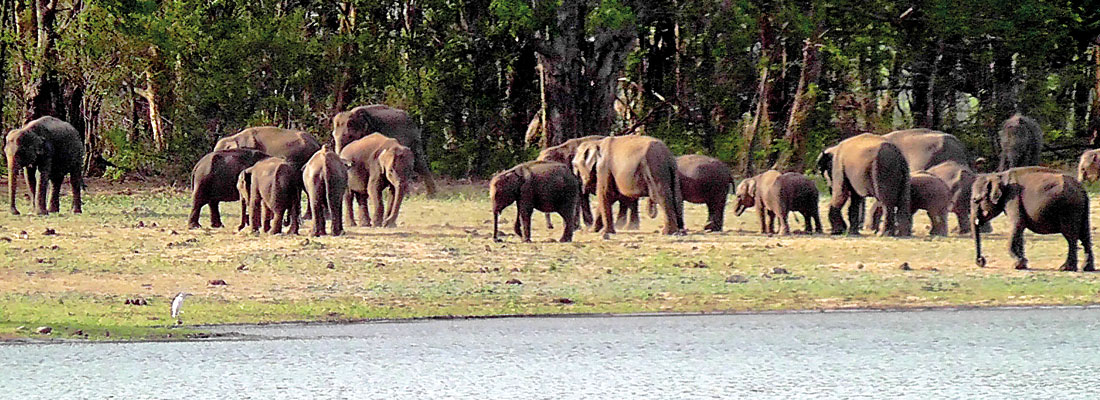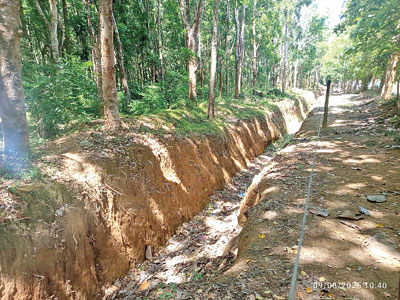News
In East, villagers convinced elephant trenches work
View(s):
Udawalawe Natioanl Park elephants
By Wasantha Chandrapala
As the struggle to minimise the human-elephant conflict continues, some of the measures taken in the eastern and southeastern parts of the country appear to have achieved some results.
Digging ditches had been criticised, but experience gained in the eastern region seems to be different, with some claiming that ditches help to keep the elephants away from homes and farmland.

Assistant Wildlife Director Prasantha Wimaladasa: New proposals are coming
One main criticism against the digging of trenches was that it was considered a destruction of the forest areas.
The scheme was abandoned, but a cross section of villagers in the eastern and surrounding areas believe that trenches provide protection.
In 2024 alone, there were 388 elephant deaths in Sri Lanka and 155 human deaths. From 2014 to 2025, 761 elephants have died in the eastern wildlife zone alone and 291 humans have died. The largest number of elephants in Sri Lanka is found in the eastern wildlife zone. According to wildlife data, there are about 1,200 wild elephants in the Maduru Oya National Park alone.
A team of journalists recently visited the areas where the problem is prevalent. There were signs that ditches dug to deter elephants do help in some areas.
N. Kuda Mahattaya of Anapallama village in the Monaragala district runs a small shop on the Wellawaya-Monaragala road. He said that he can now keep his shop open till about 8 p.m.
“Elephants used to come to our village, but now wild elephants don’t come to our village because of the elephant ditch that has been cut all the way.” He said the ditch needs to be maintained at least once every two years. “We have relief because of this ditch.’’
S. Parakrama, also from Anna Pallama, said that the trench seemed to provide protection.
“But even if we are safe, the elephant has nothing to eat. I suggest that we grow some food that they like; otherwise, those animals will die. This is a matter for the wildlife and the community. Another advantage of the ditch is that those felling trees do not come in,’’ he said.

N. Kuda Mahattaya says he now keeps his shop open till 8pm
R.M. Devika from Udawalawe said, “We have been suffering for years because of elephants. The Udawalawe National Park is in front of our house. There was an elephant fence, but it was useless. The animals come and are then chased away by wildlife officials. Later, a large trench was cut, and the elephants stopped coming to the village. But the trench was not cut continuously. People said that someone had filed a case.’’
Eastern Wildlife Veterinarian Nihal Pushpa Kumara said, “I have been working as a veterinary surgeon in the Department of Wildlife since 2012. I treat wild elephants and do post-mortems. From my experience, I can say that a large number of wild elephants die not due to natural causes but due to human activities. What we see most often is shooting and gunshot wounds.
“This situation can actually be eliminated, and people should be made aware of it. Wildlife health management is not about giving medicine to a sick animal. We need a forward-looking vision. We should work to prevent further damage to a population. Our primary responsibility is to know what to do to prevent the animal population from suffering any major disaster.
“What is happening now is that people are clearing the forests and clearing them until they reach the edge of the village. Then we grow food suitable for the animals. For example, we grow pumpkin, watermelon, and corn. Elephants really like these foods. They are easy to digest, so when there is no food in the forest, the animals eat these. This is where the conflict begins.’’
Once they get used to electric fences, they break the fences. So we need to quickly prepare the types of food that animals like in the forest, he said.

Udawalawe National Park Custodian Janaka Shantha Kumara says elephants' food issue is being addressed
Janaka Shantha Kumara, custodian of Udawalawe National Park, said that the park is home to mostly elephants who roam seeking food.
“However, we have now started cultivating food for elephants in the Udawalawe National Park, especially by growing grasses that elephants like. This is happening. To stop elephants roaming, there are electric fences and ditches. Elephants do not roam around on the side where the ditches are cut. They jump on the side where there are no ditches,’ he said.
Prasantha Wimaladasa, assistant wildlife director in charge of the east, said the Department of Wildlife is implementing long-term, short-term, and medium-term programmes.
“We have been building elephant fences for more than two decades to separate wildlife reserves from human settlements. Initially, we had to build electric fences around our reserves. But since they had shortcomings, we started building fences around villages. We are making new proposals to start temporary electric fences to protect the land during the cultivation period. After the harvest, the fence is removed. Then, the wild animals can eat the remaining parts of the crop.’’

The Anapallama trench: Residents say the ditch has stopped elephants from coming into the village
The best way to say that you found the home of your dreams is by finding it on Hitad.lk. We have listings for apartments for sale or rent in Sri Lanka, no matter what locale you're looking for! Whether you live in Colombo, Galle, Kandy, Matara, Jaffna and more - we've got them all!

